Comparing Benzodithiophene Unit with Alkylthionaphthyl and Alkylthiobiphenyl Side-Chains in Constructing High-Performance Nonfullerene Solar Cells
Abstract
1. Introduction
2. Experimental Section
2.1. Materials and Reagents
2.2. Synthesis of PBDTNS-FTAZ and PBDTBPS-FTAZ
2.3. Synthesis of Polymer PBDTNS-FTAZ
2.4. Synthesis of Polymer PBDTBPS-FTAZ
2.5. Device Characterization
3. Result and Discussion
3.1. Synthesis and Characterization
3.2. Optical Properties
3.3. Electrochemical Properties
3.4. Photovoltaic Properties
3.5. Charge Transport Characteristics
3.6. Morphology Characterization
4. Conclusions
Supplementary Materials
Author Contributions
Funding
Conflicts of Interest
References
- Liu, Y.; Zhao, J.; Li, Z.; Mu, C.; Ma, W.; Hu, H.; Jiang, K.; Lin, H.; Ade, H.; Yan, H. Aggregation and morphology control enables multiple cases of high-efficiency polymer solar cells. Nat. Commun. 2014, 5, 5293. [Google Scholar] [CrossRef] [PubMed]
- Chen, Y.; Ye, P.; Zhu, Z.G.; Wang, X.; Yang, L.; Xu, X.; Wu, X.; Dong, T.; Zhang, H.; Hou, J.; et al. Achieving high-performance ternary organic solar cells through tuning acceptor alloy. Adv. Mater. 2016, 29, 1603154. [Google Scholar] [CrossRef] [PubMed]
- Li, Y. Molecular design of photovoltaic materials for polymer solar cells: Toward suitable electronic energy levels and broad absorption. Acc. Chem. Res. 2012, 45, 723–733. [Google Scholar] [CrossRef] [PubMed]
- Lu, L.; Zheng, T.; Wu, Q.; Schneider, A.M.; Zhao, D.; Yu, L. Recent advances in bulk heterojunction polymer solar cells. Chem. Rev. 2015, 115, 12666–12731. [Google Scholar] [CrossRef]
- Cheng, Y.J.; Yang, S.H.; Hsu, C.S. Synthesis of conjugated polymers for organic solar cell applications. Chem. Rev. 2009, 109, 5868–5923. [Google Scholar] [CrossRef]
- Tang, H.; Chen, H.; Yan, C.; Huang, J.; Fong, P.W.K.; Lv, J.; Hu, D.; Singh, R.; Kumar, M.; Xiao, Z.; et al. Delicate Morphology Control Triggers 14.7% Efficiency All-Small-Molecule Organic Solar Cells. Adv. Energy Mater. 2020. [Google Scholar] [CrossRef]
- Baran, D.; Ashraf, R.S.; Hanifi, D.A.; Abdelsamie, M.; Gasparini, N.; Röhr, J.A.; Holliday, S.; Wadsworth, A.; Lockett, S.; Neophytou, M.; et al. Reducing the efficiency–stability–cost gap of organic photovoltaics with highly efficient and stable small molecule acceptor ternary solar cells. Nat. Mater. 2017, 16, 363–369. [Google Scholar] [CrossRef]
- Qiao, S.; Li, X.; Wang, H.; Zhang, B.; Li, Z.; Zhao, J.; Chen, W.; Yang, R. Temperature-Dependent and Aggregation-Breaking Strategy for Benzodifuran-Constructed Organic Solar Cells. Sol. Rrl. 2019, 3, 1900159. [Google Scholar] [CrossRef]
- Dai, S.; Zhao, F.; Zhang, Q.; Lau, T.K.; Li, T.; Liu, K.; Ling, Q.; Wang, C.; Lu, X.; You, W.; et al. Fused nonacyclic electron acceptors for efficient polymer solar cells. J. Am. Chem. Soc. 2017, 139, 1336–1343. [Google Scholar] [CrossRef]
- Yang, Y.; Zhang, Z.G.; Bin, H.; Chen, S.; Gao, L.; Xue, L.; Yang, C.; Li, Y. Side-chain isomerization on an n-type organic semiconductor ITIC acceptor makes 11.77% high efficiency polymer solar cells. J. Am. Chem. Soc. 2016, 138, 15011–15018. [Google Scholar] [CrossRef]
- Bin, H.; Gao, L.; Zhang, Z.G.; Yang, Y.; Zhang, Y.; Zhang, C.; Chen, S.; Xue, L.; Yang, C.; Xiao, M.; et al. 11.4% Efficiency non-fullerene polymer solar cells with trialkylsilyl substituted 2D-conjugated polymer as donor. Nat. Mater. 2016, 7, 13651. [Google Scholar] [CrossRef] [PubMed]
- Liu, D.; Yang, B.; Jang, B.; Xu, B.; Zhang, S.; He, C.; Woo, H.Y.; Hou, J. Molecular design of a wide-band-gap conjugated polymer for efficient fullerene-free polymer solar cells. Energy Environ. Sci. 2017, 10, 546–551. [Google Scholar] [CrossRef]
- Liu, Z.; Wang, N. Complementary light absorption and efficient exciton dissociation lead to efficient and excellent ternary polymer solar cells. J. Mater. Chem. A 2020, 8, 3211–3221. [Google Scholar] [CrossRef]
- Pan, M.A.; Lau, T.K.; Tang, Y.; Wu, Y.C.; Liu, T.; Li, K.; Chen, M.C.; Lu, X.; Ma, W.; Zhan, C. 16.7%-efficiency ternary blended organic photovoltaic cells with PCBM as the acceptor additive to increase the open-circuit voltage and phase purity. J. Mater. Chem. A 2019, 7, 20713–20722. [Google Scholar] [CrossRef]
- Guldi, D.M.; Illescas, B.M.; Ma, A.C.; Wielopolskia, M.; Martin, N. Fullerene for organic electronics. Chem. Soc. Rev. 2009, 38, 1587–1597. [Google Scholar] [CrossRef]
- He, Y.; Li, Y. Fullerene derivative acceptors for high performance polymer solar cells. Phys. Chem. Chem. Phys. 2011, 13, 1970–1983. [Google Scholar] [CrossRef]
- Lin, Y.; Wang, J.; Zhang, Z.G.; Bai, H.; Li, Y.; Zhu, D.; Zhan, X. An electron acceptor challenging fullerenes for efficient polymer solar cells. Adv. Mater. 2015, 27, 1170–1174. [Google Scholar] [CrossRef]
- Jiang, H.; Li, X.; Wang, H.; Huang, G.; Chen, W.; Zhang, R.; Yang, R. Appropriate Molecular Interaction Enabling Perfect Balance Between Induced Crystallinity and Phase Separation for Efficient Photovoltaic Blends. Acs Appl. Mater. Interfaces 2020, 12, 26286–26292. [Google Scholar] [CrossRef]
- Zhao, F.; Dai, S.; Wu, Y.; Zhang, Q.; Wang, J.; Jiang, L.; Ling, Q.; Wei, Z.; Ma, W.; You, W.; et al. Single-junction binary-blend nonfullerene polymer solar cells with 12.1% efficiency. Adv. Mater. 2017, 29, 1700144. [Google Scholar] [CrossRef]
- Li, X.; Huang, G.; Zheng, N.; Li, Y.; Kang, X.; Qiao, S.; Jiang, H.; Chen, W.; Yang, R. High-Efficiency Polymer Solar Cells Over 13.9% With a High VOC Beyond 1.0 V by Synergistic Effect of Fluorine and Sulfur. Sol. Rrl. 2019, 3, 1900005. [Google Scholar] [CrossRef]
- Zhang, Z.G.; Li, Y. Side-chain engineering of high-efficiency conjugated polymer photovoltaic materials. Sci. China Chem. 2015, 58, 192–209. [Google Scholar] [CrossRef]
- Ma, X.; An, Q.; Ibraikulov, O.A.; Lévêque, P.; Heiser, T.; Leclerc, N.; Zhang, X.; Zhang, F. Detecting bacteria and determining their susceptibility to antibiotics by stochastic confinement in nanoliter droplets using plug-based microfluidics. J. Mater. Chem. A 2020, 8, 1265–1272. [Google Scholar] [CrossRef]
- Yan, T.; Song, W.; Huang, J.; Peng, R.; Huang, L.; Ge, Z. 16.67% rigid and 14.06% flexible organic solar cells enabled by ternary heterojunction strategy. Adv. Mater. 2019, 31, 1902210. [Google Scholar] [CrossRef] [PubMed]
- Yan, T.; Ge, J.; Lei, T.; Zhang, W.; Song, W.; Fanady, B.; Zhang, D.; Chen, S.; Peng, R.; Ge, Z. 16.55% efficiency ternary organic solar cells enabled by incorporating a small molecular donor. J. Mater. Chem. A 2019, 7, 25894–25899. [Google Scholar] [CrossRef]
- Ma, Y.; Zhou, X.; Cai, D.; Tu, Q.; Ma, W.; Zheng, Q. A minimal benzo[c][1,2,5]thiadiazole-based electron acceptor as a third component material for ternary polymer solar cells with efficiencies exceeding 16.0%. Mater. Horiz. 2020, 7, 117–124. [Google Scholar] [CrossRef]
- Xu, X.; Feng, K.; Lee, Y.W.; Woo, H.Y.; Zhang, G.; Peng, Q. Subtle polymer donor and molecular acceptor design enable efficient polymer solar cells with a very small energy loss. Adv. Funct. Mater. 2020, 30, 1907570. [Google Scholar] [CrossRef]
- Zhan, L.; Li, S.; Lau, T.K.; Cui, Y.; Lu, X.; Shi, M.; Li, C.Z.; Li, H.; Hou, J.; Chen, H. Over 17% efficiency ternary organic solar cells enabled by two non-fullerene acceptors working in an alloy-like model. Energy Environ. Sci. 2020, 13, 635–645. [Google Scholar] [CrossRef]
- An, Q.; Wang, J.; Gao, W.; Ma, X.; Hu, Z.; Gao, J.; Xu, C.; Hao, M.; Zhang, X.; Yang, C.; et al. Alloy-like ternary polymer solar cells with over 17.2% efficiency. Sci. Bull. 2020, 65, 538–545. [Google Scholar] [CrossRef]
- Hou, J.; Park, M.H.; Zhang, S.; Yao, Y.; Chen, L.M.; Li, J.H.; Yang, Y. Bandgap and molecular energy level control. of conjugated polymer photovoltaic materials based on benzo[1,2-b:4,5-b’]dithiophene. Macromolecules 2008, 41, 6012–6018. [Google Scholar] [CrossRef]
- Liang, Y.; Xu, Z.; Xia, J.; Tsai, S.T.; Wu, Y.; Li, G.; Ray, C.; Yu, L. For the bright future-bulk heterojunction polymer solar cells with power conversion efficiency of 7.4%. Adv. Mater. 2010, 22, E135–E138. [Google Scholar] [CrossRef]
- Zhang, M.; Gu, Y.; Guo, X.; Liu, F.; Zhang, S.; Huo, L.; Russell, T.P.; Hou, J. Efficient polymer solar cells based on benzothiadiazole and alkylphenyl substituted benzodithiophene with a power conversion efficiency over 8%. Adv. Mater. 2013, 25, 4944–4949. [Google Scholar] [CrossRef] [PubMed]
- Zhang, M.; Guo, X.; Zhang, S.; Hou, J. Synergistic effect of fluorination on molecular energy level modulation in highly efficient photovoltaic polymers. Adv. Mater. 2014, 26, 1118–1123. [Google Scholar] [CrossRef] [PubMed]
- Song, J.; Li, C.; Zhu, L.; Guo, J.; Xu, J.; Zhang, X.; Weng, K.; Zhang, K.; Min, J.; Hao, X.; et al. Ternary organic solar cells with efficiency >16.5% based on two compatible nonfullerene acceptors. Adv. Mater. 2019, 31, 1905645. [Google Scholar] [CrossRef] [PubMed]
- Xie, G.; Zhang, Z.; Su, Z.; Zhang, X.; Zhang, J. 16.5% efficiency ternary organic photovoltaics with two polymer donors by optimizing molecular arrangement and phase separation. Nano Energy 2020, 69, 104447. [Google Scholar] [CrossRef]
- Chen, W.; Huang, G.; Li, X.; Li, Y.; Wang, H.; Jiang, H.; Zhao, Z.; Yu, D.; Wang, E.; Yang, R. Revealing the position effect of an alkylthio side chain in phenyl-substituted benzodithiophene-based donor polymers on the photovoltaic performance of non-fullerene organic solar cells. ACS Appl. Mater. Interfaces 2019, 11, 33173–33178. [Google Scholar] [CrossRef]
- Chen, W.; Huang, G.; Li, X.; Wang, H.; Li, Y.; Jiang, H.; Zheng, N.; Yang, R. Side-chain-promoted benzodithiophene-based conjugated polymers toward striking enhancement of photovoltaic properties for polymer solar cells. ACS Appl. Mater. Interfaces 2018, 10, 42747–42755. [Google Scholar] [CrossRef]
- Jiang, H.; Li, X.; Wang, H.; Ren, Z.; Zheng, N.; Wang, X.; Li, Y.; Chen, W.; Yang, R. Significantly enhanced molecular stacking in ternary bulk heterojunctions enabled by an appropriate side group on donor polymer. Adv. Sci. 2020, 7, 1903455. [Google Scholar] [CrossRef]
- Cabanetos, C.; El Labban, A.; Bartelt, J.A.; Douglas, J.D.; Mateker, W.R.; Frechet, J.M.J.; McGehee, M.D.; Beaujuge, P.M. Linear side chains in Benzo[1,2-b:4,5-b’]dithiophene-Thieno[3,4-c]pyrrole-4,6-dione polymers direct self-assembly and solar cell performance. J. Am. Chem. Soc. 2013, 135, 4656–4659. [Google Scholar] [CrossRef]
- Chen, M.S.; Lee, O.P.; Niskala, J.R.; Yiu, A.T.; Tassone, C.J.; Schmidt, K.; Beaujuge, P.M.; Onishi, S.S.; Toney, M.F.; Zettl, A.; et al. Enhanced solid-state order and field-effect hole mobility through control of nanoscale polymer aggregation. J. Am. Chem. Soc. 2013, 135, 19229–19236. [Google Scholar] [CrossRef]
- Cong, Z.; Zhao, B.; Wu, H.; Guo, Z.; Wang, W.; Luo, G.; Xu, J.; Xia, Y.; Gao, C.; An, Z. Synthesis of copolymers based on benzo[1,2-b:4,5-b ’]difuran and fluorinated quinoxaline derivatives and their photovoltaic properties. Polymer 2015, 67, 55–62. [Google Scholar] [CrossRef]
- Huo, L.; Zhang, S.; Guo, X.; Xu, F.; Li, Y.; Hou, J. Replacing alkoxy groups with alkylthienyl groups: A feasible approach to improve the properties of photovoltaic polymers. Angew. Chem. 2011, 123, 9871–9876. [Google Scholar] [CrossRef]
- Gong, X.; Li, G.; Li, C.; Zhang, J.; Bo, Z. Benzothiadiazole based conjugated polymers for high performance polymer solar cells. J. Mater. Chem. A 2015, 3, 20195–20200. [Google Scholar] [CrossRef]
- Kim, J.H.; Song, C.E.; Kim, B.; Kang, I.N.; Shin, W.S.; Hwang, D.H. Thieno[3,2-b]thiophene-Substituted benzo[1,2-b:4,5-b’]dithiophene as a promising building block for low bandgap semiconducting polymers for high-Performance single and tandem organic photovoltaic cells. Chem. Mater. 2014, 26, 1234–1242. [Google Scholar] [CrossRef]
- Xie, R.Y.; Fang, K.J.; Liu, Y.; Chen, W.C.; Fan, J.N.; Wang, X.W.; Ren, Y.F.; Song, Y.W. Z-scheme In2O3/WO3 heterogeneous photocatalysts with enhanced visible-light-driven photocatalytic activity toward degradation of organic dyes. J. Mater. Sci. 2020, 55, 11919–11937. [Google Scholar] [CrossRef]
- Wang, J.; Xiao, M.; Chen, W.; Qiu, M.; Du, Z.; Zhu, W.; Wen, S.; Wang, N.; Yang, R. Extending pi-conjugation system with benzene: An effective method to improve the properties of benzodithiophene-based polymer for highly efficient organic solar cells. Macromolecules 2014, 47, 7823–7830. [Google Scholar] [CrossRef]
- Li, X.; Huang, G.; Chen, W.; Jiang, H.; Qiao, S.; Yang, R. Size Effect of Two-Dimensional Conjugated Space in Photovoltaic Polymers’ Side Chain: Balancing Phase Separation and Charge Transport. ACS Appl. Mater. Interfaces 2020, 12, 16670–16678. [Google Scholar] [CrossRef]
- Yao, H.; Zhang, H.; Ye, L.; Zhao, W.; Zhang, S.; Hou, J. Molecular design and application of a photovoltaic polymer with improved optical properties and molecular energy levels. Macromolecules 2015, 48, 3493–3499. [Google Scholar] [CrossRef]
- Ding, D.; Wang, J.; Du, Z.; Li, F.; Chen, W.; Liu, F.; Li, H.; Sun, M.; Yang, R. A novel naphthyl side-chained benzodithiophene polymer for efficient photovoltaic cells with a high fill factor of 75%. J. Mater. Chem. A 2017, 5, 10430–10436. [Google Scholar] [CrossRef]
- Cui, C.; Wong, W.Y.; Li, Y. Improvement of open-circuit voltage and photovoltaic properties of 2D-conjugated polymers by alkylthio substitution. Energy Environ. Sci. 2014, 7, 2276–2284. [Google Scholar] [CrossRef]
- Kan, B.; Zhang, Q.; Li, M.; Wan, X.; Ni, W.; Long, G.; Wang, Y.; Yang, X.; Feng, H.; Chen, Y. Solution-processed organic solar cells based on dialkylthiol-substituted benzodithiophene unit with efficiency near 10%. J. Am. Chem. Soc. 2014, 136, 15529–15532. [Google Scholar] [CrossRef]
- Kan, B.; Zhang, Q.; Liu, F.; Wan, X.; Wang, Y.; Ni, W.; Yang, X.; Zhang, M.; Zhang, H.; Russell, T.P.; et al. Small molecules based on alkyl/alkylthio-thieno[3,2-b]thiophene-substituted benzo[1,2-b:4,5-b’]dithiophene for solution-processed solar cells with high performance. Chem. Mater. 2015, 27, 8414–8423. [Google Scholar] [CrossRef]
- Cui, C.; He, Z.; Wu, Y.; Cheng, X.; Wu, H.; Li, Y.; Cao, Y.; Wong, W.Y. A viscosity sensitive fluorescent dye for real-time monitoring of mitochondria transport in neurons. Energy Environ. Sci. 2016, 9, 885–891. [Google Scholar] [CrossRef]
- Kim, H.; Lim, B.; Heo, H.; Nam, G.; Lee, H.; Lee, J.Y.; Lee, J.; Lee, Y. High-efficiency organic photovoltaics with two-dimensional conjugated benzodithiophene-based regioregular polymers. Chem. Mater. 2017, 29, 4301–4310. [Google Scholar] [CrossRef]
- Wang, H.; Kong, H.; Zheng, J.; Peng, H.; Cao, C.; Qi, Y.; Fang, K.; Chen, W. Systematically Exploring Molecular Aggregation and Its Impact on Surface Tension and Viscosity in High Concentration Solutions. Molecules 2020, 25, 1588. [Google Scholar] [CrossRef]
- He, Z.; Zhong, C.; Huang, X.; Wong, W.Y.; Wu, H.; Chen, L.; Su, S.; Cao, Y. Simultaneous enhancement of open-circuit voltage, short-circuit current density, and fill factor in polymer solar cells. Adv. Mater. 2011, 23, 4636–4643. [Google Scholar] [CrossRef]
- Zhang, Q.; Kan, B.; Liu, F.; Long, G.; Wan, X.; Chen, X.; Zuo, Y.; Ni, W.; Zhang, H.; Li, M.; et al. Small-molecule solar cells with efficiency over 9%. Nat. Photonics 2015, 9, 35–41. [Google Scholar] [CrossRef]
- Chen, W.; Du, Z.; Xiao, M.; Zhang, J.; Yang, C.; Han, L.; Bao, X.; Yang, R. High-performance small molecule/polymer ternary organic solar cells based on a layer-by-layer process. ACS Appl. Mater. Interfaces 2015, 7, 23190–23196. [Google Scholar] [CrossRef]
- Chen, W.; Shen, W.; Wang, H.; Liu, F.; Duan, L.; Xu, X.; Zhu, D.; Qiu, M.; Wang, E.; Yang, R. Enhanced efficiency of polymer solar cells by improving molecular aggregation and broadening the absorption spectra. Dye. Pigm. 2019, 166, 42–48. [Google Scholar] [CrossRef]
- Jiang, H.; Li, X.; Wang, J.; Qiao, S.; Zhang, Y.; Zheng, N.; Chen, W.; Li, Y.; Yang, R. Ternary Polymer solar cells with high efficiency of 14.24% by integrating two well-complementary nonfullerene acceptors. Adv. Funct. Mater. 2019, 29, 1903596. [Google Scholar] [CrossRef]
- Lenes, M.; Morana, M.; Brabec, C.J.; Blom, P.W.M. Recombination-limited photocurrents in low bandgap polymer/fullerene solar cells. Adv. Funct. Mater. 2009, 19, 1106–1111. [Google Scholar] [CrossRef]
- Jiang, H.; Li, X.; Liang, Z.; Huang, G.; Chen, W.; Zheng, N.; Yang, R. Employing structurally similar acceptors as crystalline modulators to construct high efficiency ternary organic solar cells. J. Mater. Chem. A 2019, 7, 7760–7765. [Google Scholar] [CrossRef]
- Li, X.; Liang, Z.; Wang, H.; Qiao, S.; Liu, Z.; Jiang, H.; Chen, W.; Yang, R. Fluorinated D1((0.5))-A-D2((0.5))-A model terpolymer: Ultrafast charge separation kinetics and electron transfer at the fluorinated D/A interface for power conversion. J. Mater. Chem. A 2020, 8, 1360–1367. [Google Scholar] [CrossRef]
- Li, X.; Huang, G.; Jiang, H.; Qiao, S.; Kang, X.; Chen, W.; Yang, R. Novel benzodithiophene unit with an alkylthiobiphenyl side chain for constructing high-efficiency polymer solar cells. J. Mater. Chem. C 2019, 7, 6105–6111. [Google Scholar] [CrossRef]
- Wang, J.; Bao, X.; Ding, D.; Qiu, M.; Du, Z.; Wang, J.; Liu, J.; Sun, M.; Yang, R. A fluorine-induced high-performance narrow bandgap polymer based on thiadiazolo[3,4-c]pyridine for photovoltaic applications. J. Mater. Chem. A 2016, 4, 11729–11737. [Google Scholar] [CrossRef]
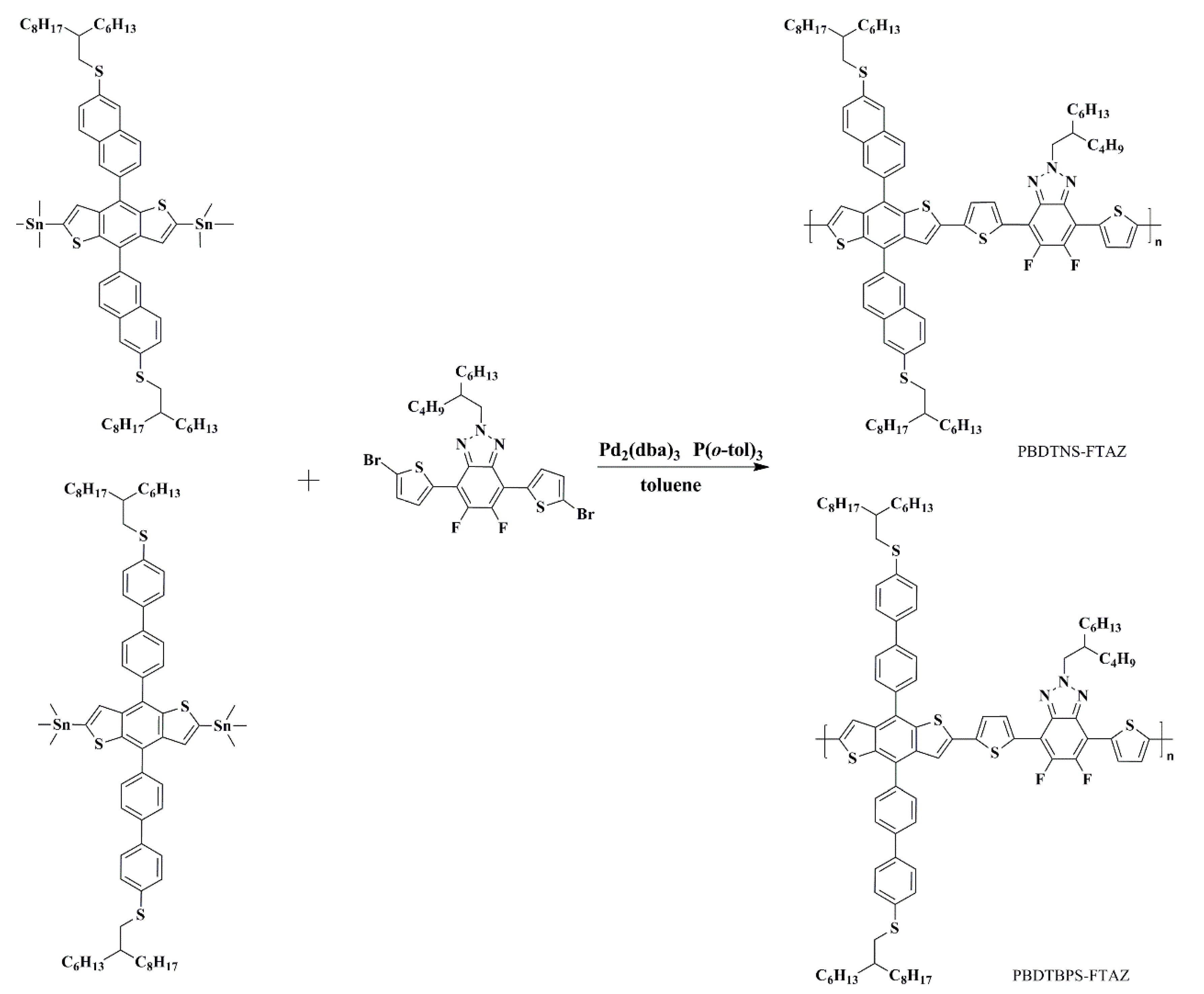
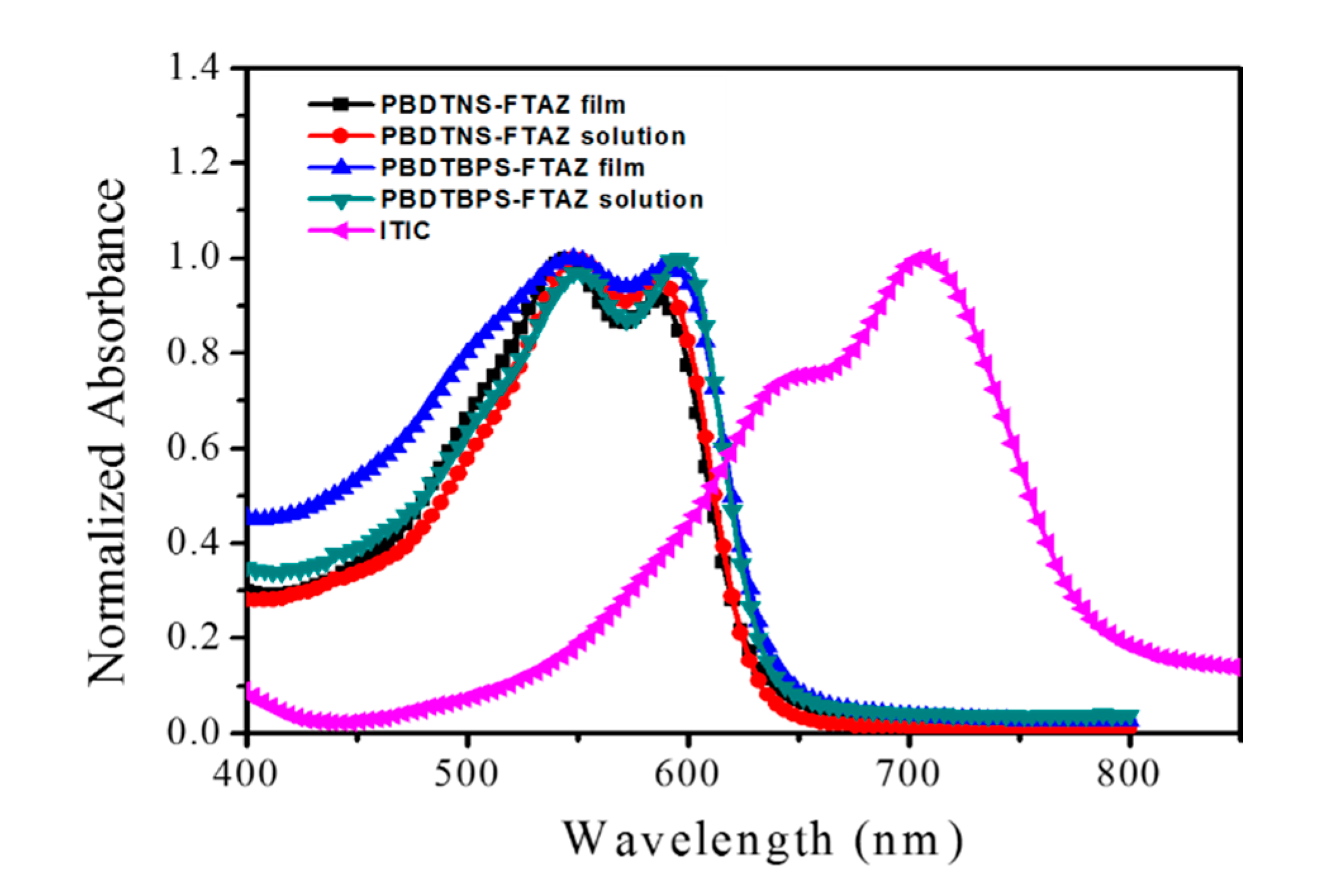
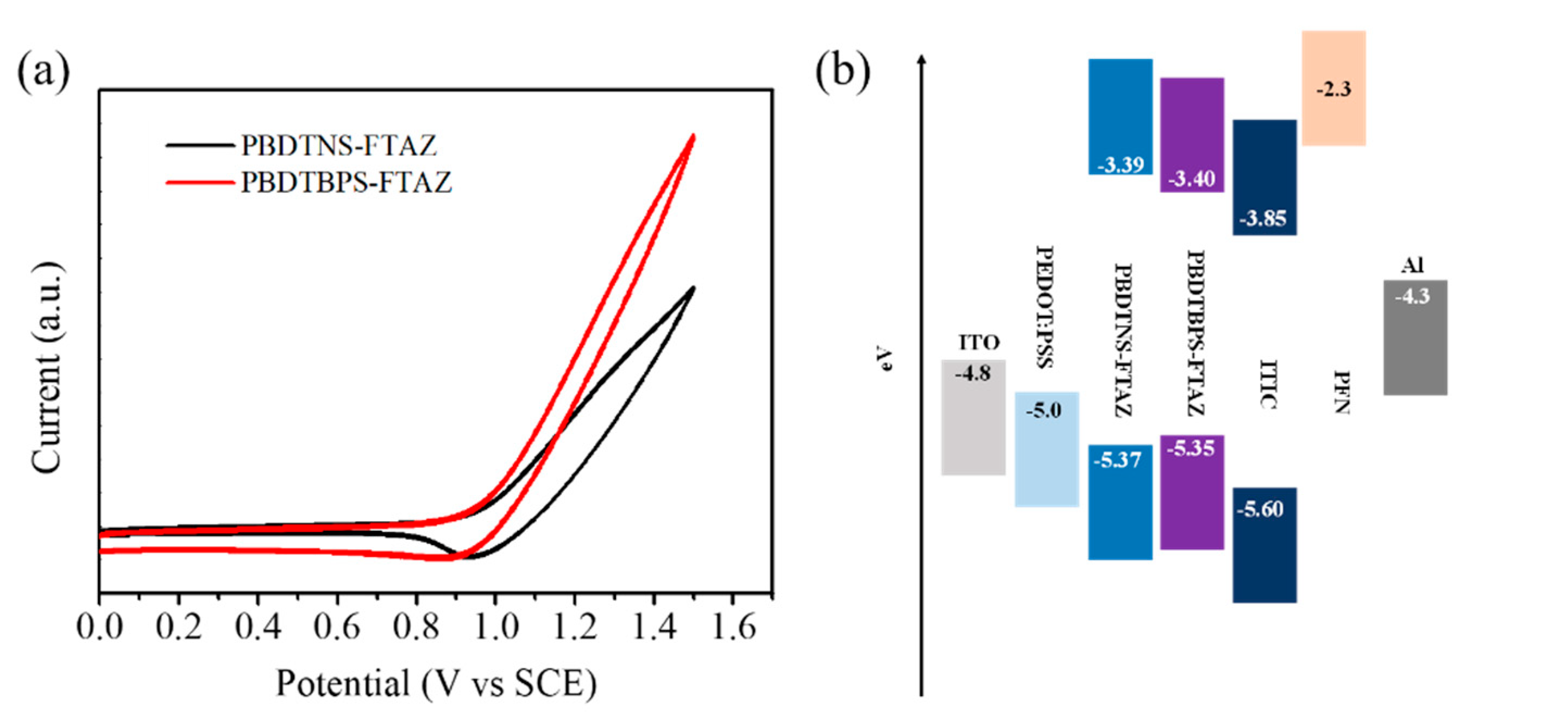
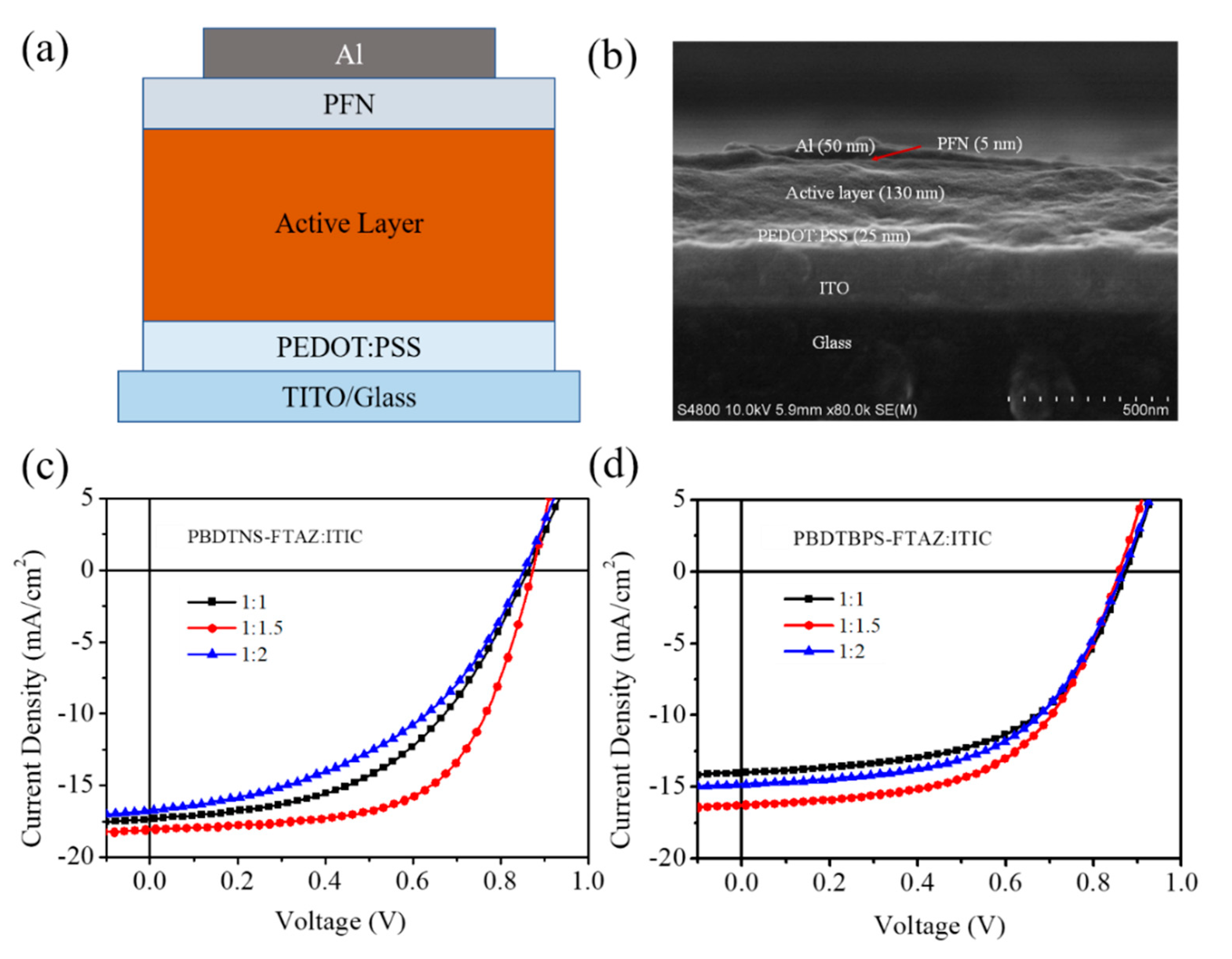


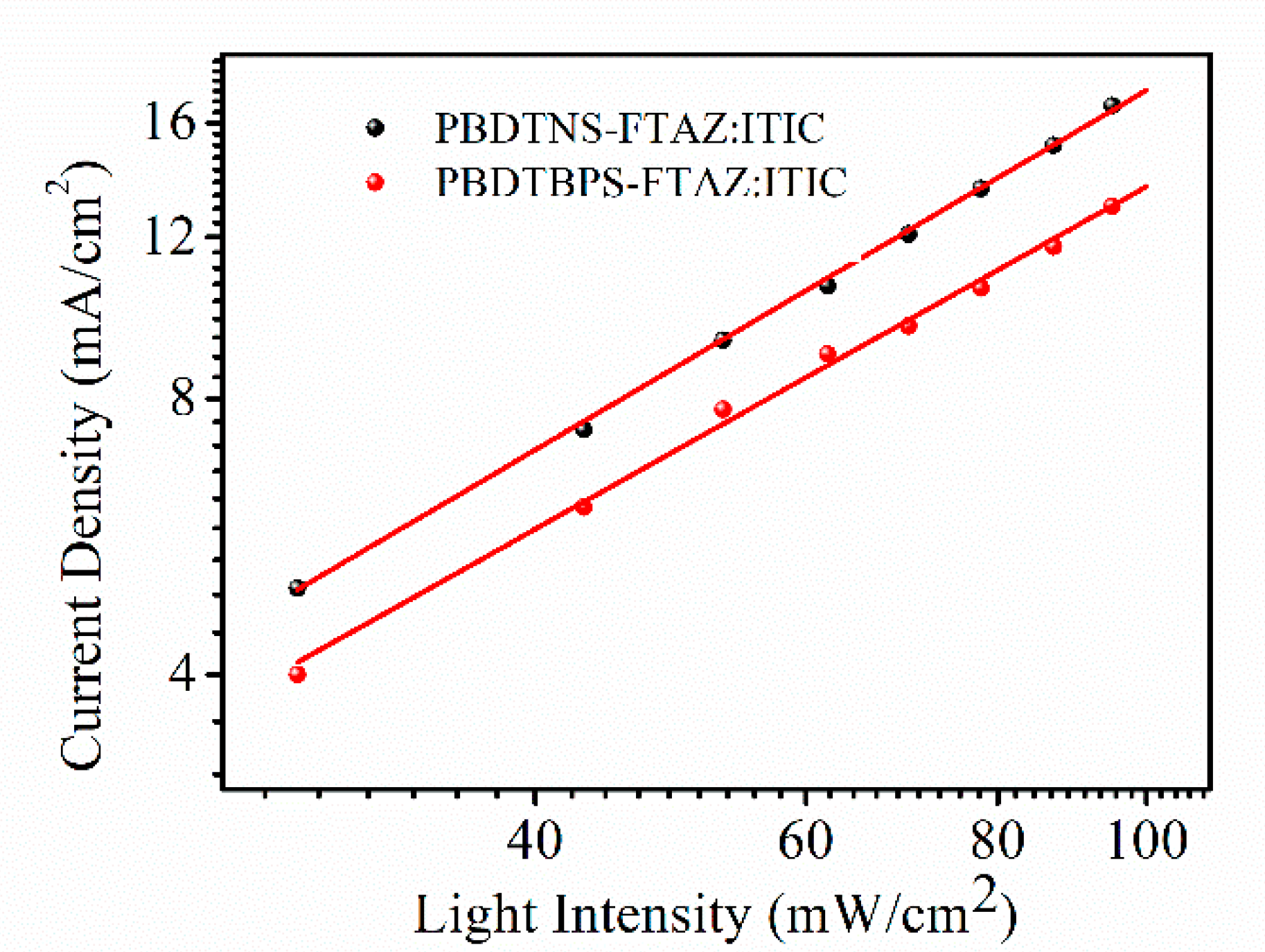
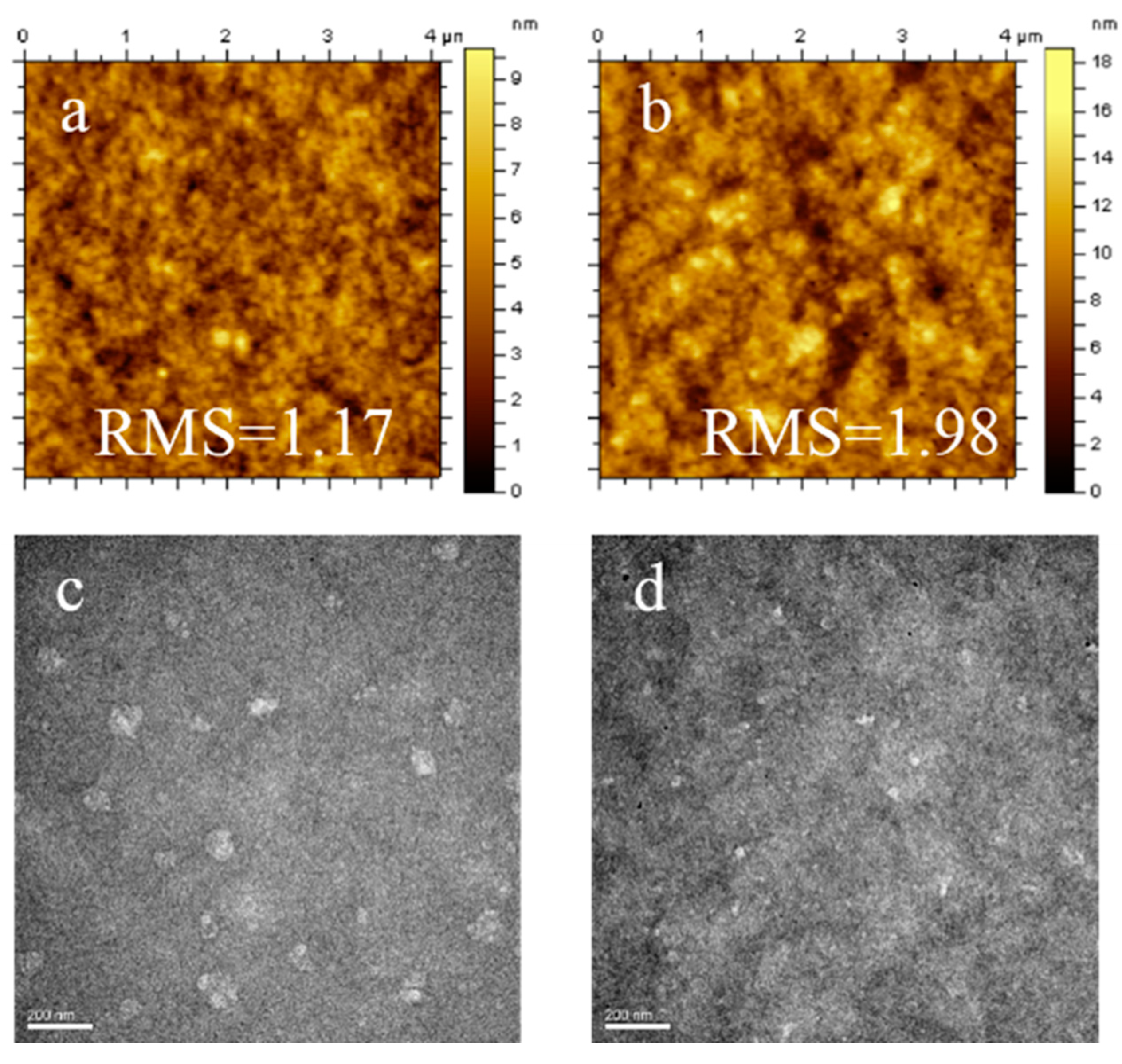
| Polymer | D/A Ratios (w:w) | Voc (V) | Jsc (mA/cm2) | FF (%) | PCEmax (%) |
|---|---|---|---|---|---|
| PBDTNS-FTAZ | 1:1 | 0.88 (0.88 ± 0.01) | 15.29 (14.83 ± 0.38) | 60.39 (57.12 ± 2.36) | 8.17 (7.85 ± 0.24) |
| 1:1.5 | 0.87 (0.87 ± 0.01) | 18.06 (17.74 ± 0.43) | 61.21 (58.19 ± 2.27) | 9.64 (9.23 ± 0.36) | |
| 1:2 | 0.85 (0.85 ± 0.01) | 16.70 (16.18 ± 0.54) | 45.68 (42.37 ± 3.61) | 6.49 (6.12 ± 0.47) | |
| PBDTBPS-FTAZ | 1:1 | 0.87 (0.87 ± 0.01) | 14.52 (14.02 ± 0.39) | 56.17 (53.89 ± 3.45) | 7.08 (6.75 ± 0.31) |
| 1:1.5 | 0.86 (0.86 ± 0.01) | 16.24 (15.84 ± 0.41) | 55.92 (53.86 ± 1.98) | 7.79 (7.39 ± 0.56) | |
| 1:2 | 0.86 (0.86 ± 0.01) | 14.82 (14.42 ± 0.58) | 55.17 (53.73 ± 1.73) | 7.07 (6.46 ± 0.59) |
© 2020 by the authors. Licensee MDPI, Basel, Switzerland. This article is an open access article distributed under the terms and conditions of the Creative Commons Attribution (CC BY) license (http://creativecommons.org/licenses/by/4.0/).
Share and Cite
Xie, R.; Song, L.; Zhao, Z. Comparing Benzodithiophene Unit with Alkylthionaphthyl and Alkylthiobiphenyl Side-Chains in Constructing High-Performance Nonfullerene Solar Cells. Polymers 2020, 12, 1673. https://doi.org/10.3390/polym12081673
Xie R, Song L, Zhao Z. Comparing Benzodithiophene Unit with Alkylthionaphthyl and Alkylthiobiphenyl Side-Chains in Constructing High-Performance Nonfullerene Solar Cells. Polymers. 2020; 12(8):1673. https://doi.org/10.3390/polym12081673
Chicago/Turabian StyleXie, Ruyi, Li Song, and Zhihui Zhao. 2020. "Comparing Benzodithiophene Unit with Alkylthionaphthyl and Alkylthiobiphenyl Side-Chains in Constructing High-Performance Nonfullerene Solar Cells" Polymers 12, no. 8: 1673. https://doi.org/10.3390/polym12081673
APA StyleXie, R., Song, L., & Zhao, Z. (2020). Comparing Benzodithiophene Unit with Alkylthionaphthyl and Alkylthiobiphenyl Side-Chains in Constructing High-Performance Nonfullerene Solar Cells. Polymers, 12(8), 1673. https://doi.org/10.3390/polym12081673




